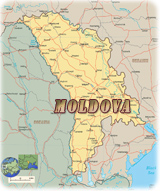
Moldova
Moldova is a in southeastern Europe. Chişinău is the capital and largest city of the country.
Present-day Moldova comprises a large part of the eastern half of the historic principality of Moldavia. At its largest extent, in the Middle Ages, the principality stretched from the Dniester River in the east almost to the Carpathian Mountains in the west. Much of the eastern half of Moldavia, between the Prut and Dniester rivers, was traditionally known as Bessarabia. Moldavian territory was divided in 1812, when the Ottoman Empire took control of all of the land west of the Prut River and Russia took control of the rest. The Russian government gave the name Bessarabia to the territory under its control to distinguish it from neighboring Ottoman-controlled Moldavia.
In 1918 Bessarabia became independent and then united with Romania. Troops of the Union of Soviet Socialist Republics occupied Bessarabia in 1940. The Soviet government joined most of Bessarabia to part of the already existing Moldavian Autonomous Soviet Socialist Republic, across the Dniester River, to form the Moldavian Soviet Socialist Republic. Romania regained Bessarabia in 1941 but lost it again to the USSR in 1944. When the USSR collapsed in 1991, the republic became the independent country of Moldova. In addition to the region of Bessarabia, present-day Moldova also includes territory along the left bank of the Dniester known as Trans-Dniester. The remainder of the historic principality of Moldavia is now part of Romania and Ukraine.
After declaring independence in 1991, Moldova signed the agreement establishing the Commonwealth of Independent States (CIS), an organization composed of former Soviet republics. Moldova became a formal member of the CIS in 1994. That year the country adopted its first post-Soviet constitution.

Fountain in Chisinau, the capital of Moldova.
|
Copyright © Geographic Guide - Maps World, European Continent. |
